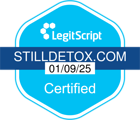Key Points
- Suboxone and Methadone are both medications for opioid use disorder (OUD) but work differently. They are both effective but have distinct characteristics.
- Suboxone uses a partial opioid agonist (buprenorphine) to reduce cravings and withdrawal with a lower overdose risk. Naloxone deters misuse.
- Methadone uses a full opioid agonist, effectively reducing cravings but with a higher overdose risk. It requires daily clinic visits for supervised dispensing.
- Suboxone generally leads to milder withdrawal and easier tapering compared to Methadone. Methadone withdrawal can be more intense, needing careful management.
- Naltrexone is a third option, an opioid antagonist for relapse prevention *after* detox. It blocks opioid effects and is different from Suboxone and Methadone.
- The best medication choice depends on individual needs, addiction severity, and treatment goals. Treatment should be tailored to the patient for optimal outcomes.
What is Suboxone?
Suboxone is a combination medication containing buprenorphine, a partial opioid agonist, and naloxone, an opioid antagonist. The buprenorphine component helps to reduce withdrawal symptoms and cravings by partially stimulating opioid receptors, while naloxone is included to deter misuse via injection. Because Suboxone has a ceiling effect, its potential for respiratory depression is lower compared to full opioid agonists, making it a safer option for many patients when used as prescribed.
What is Methadone?
Methadone is a long-acting full opioid agonist that has been used for decades in the treatment of OUD. It works by fully stimulating opioid receptors, which can alleviate withdrawal symptoms and reduce cravings. However, because it is a full agonist, Methadone carries a higher risk of overdose if not properly managed. Typically, Methadone treatment is administered in a controlled clinical setting, where daily doses are closely monitored to ensure safety.
Suboxone vs Methadone Mechanism of Action (MOA)
The fundamental difference in how Suboxone and Methadone work lies in their mechanism of action. Suboxone contains buprenorphine, a partial opioid agonist, which activates opioid receptors to a lesser degree than full agonists. This means that after a certain dose, increasing the amount does not proportionally increase its effects, which reduces the risk of respiratory depression and overdose.
In contrast, Methadone is a full opioid agonist, meaning it fully stimulates opioid receptors and can produce stronger opioid effects. This difference in receptor activity is key to understanding both the efficacy and safety profiles of these medications1.
Suboxone vs Methadone Withdrawal
Withdrawal experiences can vary significantly between Suboxone and Methadone due to their differing pharmacological properties. Patients on Suboxone generally experience milder withdrawal symptoms compared to those on Methadone. The partial agonist nature of buprenorphine in Suboxone results in a ceiling effect that limits the severity of withdrawal symptoms. On the other hand, Methadone, as a full agonist, can produce more intense withdrawal symptoms that may require a more gradual tapering process. This difference is an important consideration for treatment planning and can affect the overall comfort and success of the recovery process2.
Suboxone vs Methadone vs Naltrexone
In addition to Suboxone vs Methadone, Naltrexone represents a third option for treating opioid use disorder. Unlike Suboxone and Methadone, which act as opioid agonists (partial and full, respectively), Naltrexone is an opioid antagonist. It works by blocking opioid receptors, thereby preventing any opioid effects from occurring.
This makes Naltrexone useful as a relapse prevention tool after detoxification has been achieved, but it is not effective in alleviating withdrawal symptoms. While Suboxone and Methadone are used to stabilize patients by reducing cravings and withdrawal, Naltrexone is aimed at maintaining abstinence. Each medication has its own set of benefits and challenges, and the choice among them depends on the patient’s specific needs, treatment goals, and history of opioid use3.
Key Differences Between Suboxone and Methadone
While both medications serve the same overall goal—to support recovery from opioid addiction—they differ in several important ways. The table below summarizes these key differences:
| Aspect | Suboxone | Methadone |
|---|---|---|
| Mechanism | Partial opioid agonist (buprenorphine) with naloxone to deter misuse | Full opioid agonist |
| Withdrawal | Milder withdrawal symptoms; easier tapering process | More intense withdrawal symptoms; requires careful tapering |
| Administration | Prescribed in office-based settings for take-home use | Dispensed daily in controlled clinic environments |
| Safety Profile | Lower risk of overdose due to ceiling effect | Higher risk of overdose if misused |
Treatment Considerations
Choosing between Suboxone vs Methadone and Naltrexone depends on multiple factors, including the severity of opioid dependence, patient history, and access to treatment facilities. Suboxone’s office-based treatment model may be preferable for individuals who value privacy and require less frequent clinic visits, while Methadone’s structured program can offer intensive support for those with severe opioid use disorder. Naltrexone, with its unique mechanism as an opioid antagonist, is best suited for patients who have already achieved detoxification and wish to maintain abstinence.
As Dr. Nora Volkow of NIDA emphasizes, “Effective treatment for opioid use disorder must be individualized, taking into account both the pharmacological properties of the medication and the unique circumstances of the patient”2.
References
- National Institutes of Health. Opioid Use Disorder and Its Treatment. Available at: https://www.nih.gov.
- National Institute on Drug Abuse. Principles of Addiction Treatment: A Research-Based Guide. Available at: https://www.drugabuse.gov.
- American Psychiatric Association. Practice Guidelines for the Treatment of Patients with Opioid Use Disorder. Available at: https://www.psychiatry.org.








